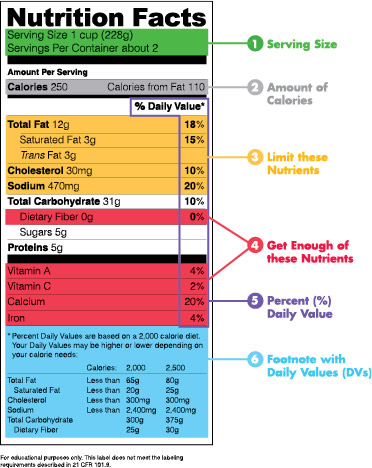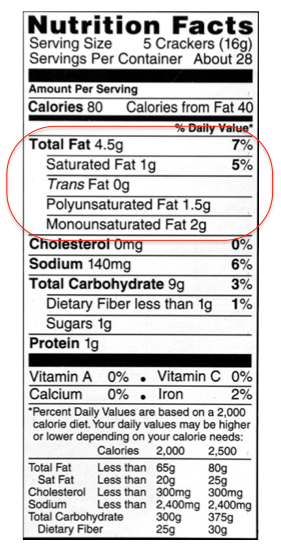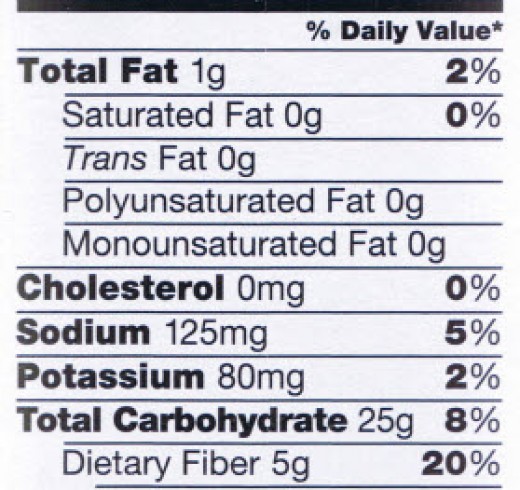38 understanding fat on nutrition labels
Understanding Food Nutrition Labels | Sanford Fit Nutritional Information When looking at fat, carbohydrates, sodium, added sugar, and vitamins, the percent Daily Value (%DV) is a good guide. The percent Daily Value (%DV) will show how much of a nutrient is in a serving of food and contributes to a total daily diet. A general guide: 5% DV or less of a nutrient per serving is considered low. Reading and understanding the Nutrition Facts Label for health It is important to direct your attention to the top nutrient section that includes fat, saturated fat, trans fat, cholesterol, sodium and added sugars. These nutrients should be limited. Aim for eating products that have 0 percent trans fat and less than 5 percent saturated fats. Generally 5 percent or less is low and 20 percent or more is high.
How to Decode a Nutrition Label - Healthline People with eating disorders often find that nutrition labels trigger tendencies to obsess about calories, fat, or sugar. "When examined through the lens of food-preoccupation, as in chronic ...

Understanding fat on nutrition labels
Understanding Food Nutrition Labels | EmPOWERED To Serve When the Nutrition Facts label says a food contains "0 g" of trans fat, but includes "partially hydrogenated oil" in the ingredient list, it means the food contains some trans fat, but less than 0.5 grams per serving. So, if you eat more than one serving, you could end up eating too much trans fat. How to understand food nutrition labels | by Alpha Medical Team | Alpha ... The FDA recommends limiting saturated fat, sodium, and added sugars. On the other hand, it's good to get foods that are high in fiber, vitamin D, calcium, iron, and potassium, as these are some... How to Understand and Use the Nutrition Facts Label | FDA Nutrients to get less of: Saturated Fat, Sodium, and Added Sugars. Saturated fat, sodium, and added sugars are nutrients listed on the label that may be associated with adverse health effects - and...
Understanding fat on nutrition labels. Understanding Nutritional Labels - Beaumont Health Here are the parts of most food labels: Calories (total calories and calories from fat) - This part of the label tells you how many calories each serving has and how many of those calories come from fat. Total Fat - Total fat is the number of fat grams per serving. There are different types of fat. Some are good for you and some aren't. 20 Tips for Understanding Nutrition Labels | Eat This Not That Macronutrients include fat, carbs (which also breaks down into fiber and sugar), and protein. If anything stands out to you—like the product having 17 grams of fat or 25 grams of sugar—use those numbers to help you skim the ingredient list. For example, a cereal that has 6 grams of fat in it is odd. Understanding the Nutrition Facts Label - Know Diabetes by Heart Fats Although fat can also contribute to changes in your blood sugar, they have less influence than carbs. However, it is important to reduce amount of saturated and trans fats as a part of a balanced diet. Replacing foods that are high in saturated fat with healthier options can lower blood cholesterol levels and improve lipid profiles. Sodium Understanding Food Nutrition Labels | American Heart Association When the Nutrition Facts label says a food contains "0 g" of trans fat, but includes "partially hydrogenated oil" in the ingredient list, it means the food contains some trans fat, but less than 0.5 grams per serving. So, if you eat more than one serving, you could end up eating too much trans fat.
Food Labels | CDC If you eat the whole thing, you are eating 8 times the amount of calories, carbs, fat, etc., shown on the label. Total Carbohydrate shows you types of carbs in the food, including sugar and fiber. Choose foods with more fiber, vitamins, and minerals. Choose foods with lower calories, saturated fat, sodium, and added sugars. Avoid trans fat. Interpreting Total Fat and Types of Fat on Food Labels - Nina Cherie ... Now, at the end of the day, since all high-fat foods tend to drive up calorie counts, it's typically recommended that you limit your intake of total fat to 25-35% of your daily calories. Of this amount, saturated fats and trans fats should comprise less than 7-10% and no more than 1%, respectively. Food labels 101: Understanding the nutrition facts panel The general guideline is that 40 calories is low, 100 calories is moderate, and 400 calories is high. Nutrients to limit - The nutrients that should be limited are fat, cholesterol and sodium. Consuming an excess of these nutrients can increase the risk of developing chronic health conditions like diabetes, heart disease and high blood pressure. Understanding Nutrition Fact Labels | Penn Highlands Healthcare The nutrients you want more of include: dietary fiber, vitamin D, calcium, iron, and potassium. Unlike saturated fat, sodium, and sugar, Americans generally do not consume enough of these nutrients. Fiber can decrease constipation, lower blood glucose levels and cholesterol levels, while also reducing your caloric intake.
Understanding Nutrition Labels - Medical News Health experts suggest that nutrients like saturated fats, added sugars, and sodium should have a low %DV. Whereas, nutrients like vitamin D, potassium, and dietary fibers should have a high %DV.... Understanding Food Labels | The Nutrition Source | Harvard T.H. Chan ... For example, a bag of potato chips may advertise that it has 40% less fat and is cholesterol-free, suggesting it is a "healthy" food, when in reality even a "healthier" potato chip is still a high-calorie ultra-processed food offering little nutrition. Some terms are not yet regulated by the FDA such as " natural " or "multigrain." Reading Food Labels | ADA - American Diabetes Association The Nutrition Facts labels on foods are really the key to making the best choices. We'll cover the basics so that these labels make shopping easier for you. You've heard it all. From carb-free to low-carb, to whole and empty carbs, it's hard to know what it all means. Blood sugar highs and lows aren't always easy to understand. Food Labels: Fat & Cholesterol | Home & Garden Information Center The Nutrition Facts label shows you how much fat is in a product, even if the fat is hidden as an ingredient. The serving size and the nutrients listed on this label are consistent, which makes it easy to compare similar products without any calculations. % Daily Values (% DVs) are listed in a column on the "Nutrition Facts" label.
Understanding and Using the Nutrition Facts Label fat-free or 1% low-fat dairy products, eggs, lean meats packaged foods, snacks, and condiments. Limit baked and poultry, seafood, soy products, nuts, and seeds.
A Complete Guide to Reading and Understanding Nutrition & Ingredient Labels An ingredient that is present in 2% (or less) by weight isn't subject to the same regulations and instead may be listed at the end or marked with a symbol. While these quantities may be small, even tiny amounts of hidden sugars or other unwanted ingredients can add up if eaten frequently. Watch for numbers that don't add up.
Understanding Food Nutrition Labels | American Stroke Association When the Nutrition Facts label says a food contains "0 g" of trans fat, but includes "partially hydrogenated oil" in the ingredient list, it means the food contains some trans fat, but less than 0.5 grams per serving. So, if you eat more than one serving, you could end up eating too much trans fat.
Nutrition Facts Label: Understanding the Label | Extension | University ... Nutrition Facts Label: Understanding the Label. Extension / Publications / Pub. The Nutrition Facts label is designed to provide consumers with relevant information and nutrient content of food products being consumed. The goal is to assist consumers in making informed decisions about the foods they eat based on the information provided.
Understanding Food Nutrition Labels - Calorie Control Council Always looking at the Nutrition Facts label helps cut through the buzzword jargon. First, it's important to understand that sugar is not fat. Sugar is listed under the carbohydrates, which is also where you find fiber. When looking to reduce your calorie intake, choosing items using low calorie sweeteners like allulose really come in handy.
How to read nutrition labels | safefood Nutrition information can be found on the back/side of food labels. Sometimes you will also find a snapshot of this information on the front of pack. Nutrition information is displayed per 100g and sometimes per recommended serving. Use the per 100g column to compare products. Look at the recommended portion size.
How to understand food labels - Eat For Health Sometimes labels will include nutrition content claims like 'low fat', 'reduced salt' or 'high fibre'. These claims can only be used if the food meets certain criteria. For example, with a 'good source of calcium' claim, the food must contain more than a set amount of calcium. While nutrition content claims can generally guide ...
Fat Content on Food Labels - Reading Between the Lines The Mayo Foundation continued, "Still, you may be able to tell if a product contains trans fat, even if it's not directly listed on the food label. Look for the words ' hydrogenated ' or 'partially hydrogenated' in the list of ingredients. These terms indicate that the product contains trans fat.

The 5/20 rule will help you easily understand the nutrition label on your food | The Optimist Daily
Understanding Nutrition Facts on Food Labels - WebMD Serving Size: An Important Part of Food Labels. At the top of the Nutrition Facts section, you'll see the serving size (such as 1/2 cup, five crackers, or 10 chips) and servings per container (such as two, four, six). The food label then lists the number of calories, grams of fat, grams of saturated and trans fat, etc., per serving.
How to Understand and Use the Nutrition Facts Label | FDA Nutrients to get less of: Saturated Fat, Sodium, and Added Sugars. Saturated fat, sodium, and added sugars are nutrients listed on the label that may be associated with adverse health effects - and...
Five Things to Remember when Reading Nutrition Labels | K12 Physical Education and Health Assessment
How to understand food nutrition labels | by Alpha Medical Team | Alpha ... The FDA recommends limiting saturated fat, sodium, and added sugars. On the other hand, it's good to get foods that are high in fiber, vitamin D, calcium, iron, and potassium, as these are some...
Understanding Food Nutrition Labels | EmPOWERED To Serve When the Nutrition Facts label says a food contains "0 g" of trans fat, but includes "partially hydrogenated oil" in the ingredient list, it means the food contains some trans fat, but less than 0.5 grams per serving. So, if you eat more than one serving, you could end up eating too much trans fat.








Post a Comment for "38 understanding fat on nutrition labels"